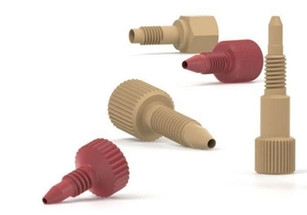16th Dec 2024
How To Make an HPLC Connection With PEEK Tubing
To make an HPLC connection with fingertight fittings, follow these steps:
- Slide the nut onto the tubing that will be inserted into the port.
- Place the ferrule onto the tubing just below the nut. For high-pressure connections, ensure the tapered edge of the ferrule faces away from the nut.
- Insert the tubing into the receiving port until it is firmly against the bottom of the port.
- While holding the tubing in place, finger-tighten the nut completely.
For more information on HPLC connections, continue reading.
PEEK (Polyetheretherketone) tubing is popular in HPLC applications because it offers excellent pressure resistance and has chemical resistance to virtually all commonly used HPLC solvents. Also, PEEK tubing is relatively inexpensive and easy to cut in the lab.
Compression fitting systems consist of a nut and a ferrule. The nut provides the driving force, and the ferrule grips the tubing. The entire system works together to provide a consistent hold on the tubing wall. Please note that some nuts and ferrules have been designed into one body piece, but they still contain a nut and ferrule. These one-piece fitting systems are sometimes more convenient and easier to use (and less likely to drop on the lab floor).
What Is the Function of Fittings in HPLC?
- Preventing liquid from leaking from the flow path
- Holding tubing in place
How To Make a High-Pressure Connection With Peek Tubing in an HPLC System
The most demanding type of HPLC connection to make is on the high-pressure side of the system. These pressures typically are around 4,000–6,000 psi. Because these higher pressures cause stress on the system, it is important to make good connections for trouble-free operation.
We Recommend Using FingerTight Fittings With PEEK Tubing
A common fitting is the FingerTight fitting. FingerTight Fittings are typically polymer fittings that do not permanently adhere to the surface of your tubing wall, which allows them to be repositioned as needed. As the name implies, these fittings can be tightened without a wrench—all you typically need are your fingers! To make a good FingerTight connection on PEEK tubing, you first need to know the outside diameter of your tubing (since the fitting system grips on the outside wall of the tubing). It is also important to know the material of your receiving port. As a general rule, when selecting the fitting, the receiving port should be made from a material at least as hard as the material of the fitting. Also, you must know the threading and geometry of your receiving port.
Once you have a nut and ferrule that is appropriate for your receiving port and that works with your PEEK tubing, you have all you need to make a FingerTight connection. First, slip the nut over the tubing being connected. Next, slip the ferrule over the tubing, just below the nut, ensuring the tapered edge of the ferrule is facing away from the nut (for high-pressure connections). Once the nut and ferrule are in place, insert the tubing into the receiving port until the tubing butts up against the bottom of the port. With the tubing held in place, finger-tighten the nut completely. Please note, this is not a permanent connection and can be repositioned as needed.
Please contact Chrom Tech to ensure you have the correct HPLC Fittings to use with your PEEK tubing. In order for us to help you best, let us know:
- Tubing Outside Diameter and Material
- Receiving Port Geometry
- Pressure of HPLC system

